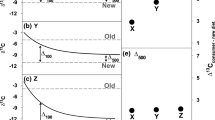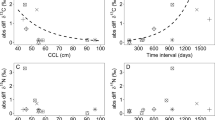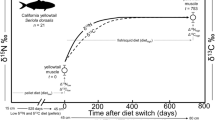Abstract
Carbon and nitrogen stable isotope analyses have improved our understanding of food webs and movement patterns of aquatic organisms. These techniques have recently been applied to diet studies of elasmobranch fishes, but isotope turnover rates and isotope diet–tissue discrimination are still poorly understood for this group. We performed a diet switch experiment on captive sandbar sharks (Carcharhinus plumbeus) as a model shark species to determine tissue turnover rates for liver, whole blood, and white muscle. In a second experiment, we subjected captive coastal skates (Leucoraja spp.) to serial salinity reductions to measure possible impacts of tissue urea content on nitrogen stable isotope values. We extracted urea from spiny dogfish (Squalus acanthias) white muscle to test for effects on nitrogen stable isotopes. Isotope turnover was slow for shark tissues and similar to previously published estimates for stingrays and teleost fishes with low growth rates. Muscle isotope data would likely fail to capture seasonal migrations or diet switches in sharks, while liver and whole blood would more closely reflect shorter term movement or shifts in diet. Nitrogen stable isotope values of skate blood and skate and dogfish white muscle were not affected by tissue urea content, suggesting that available diet–tissue discrimination estimates for teleost fishes with similar physiologies would provide accurate estimates for elasmobranchs.



Similar content being viewed by others
References
Abelson, P. H. & T. C. Hoering, 1961. Carbon isotope fractionation in formation of amino acids by photosynthetic organisms. Proceedings of the National Academy of Sciences of the United States of America 47: 623–632.
Baker, R., P. Blanchfield, M. Paterson, R. Flett & L. Wesson, 2004. Evaluation of nonlethal methods for the analysis of mercury in fish tissue. Transactions of the American Fisheries Society 133: 568–576.
Bearhop, S., M. A. Teece, S. Waldron & R. W. Furness, 2000. Influence of lipid and uric acid on δ13C and δ15N values of avian blood: implications for trophic studies. The Auk 117: 504–507.
Best, P. B. & D. M. Schell, 1996. Stable isotopes in southern right whale (Eubalaena australis) baleen as indicators of seasonal movements, feeding and growth. Marine Biology 124: 483–494.
Bligh, E. G. & W. J. Dyer, 1959. A rapid method of total lipid extraction and purification. Canadian Journal of Biochemistry and Physiology 37: 911–917.
Boag, B., R. Neilson & C. Scrimgeour, 2006. The effect of starvation on the planarian Arthurdendyus triangulatus (Tricladida: Terricola) as measured by stable isotopes. Biology and Fertility of Soils 43: 267–270.
Brill, R., P. Bushnell, S. Schroff, R. Seifert & M. Galvin, 2008. Effects of anaerobic exercise accompanying catch-and-release fishing on blood-oxygen affinity of the sandbar shark (Carcharhinus plumbeus, Nardo). Journal of Experimental Marine Biology and Ecology 354: 132–143.
Burton, R. & P. Koch, 1999. Isotopic tracking of foraging and long-distance migration in northeastern Pacific pinnipeds. Oecologia 119: 578–585.
Cain, D., C. Harms & A. Segars, 2004. Plasma biochemistry reference values of wild-caught southern stingrays (Dasyatis americana). Journal of Zoo and Wildlife Medicine 35: 471–476.
Carey, F. G. & J. M. Teal, 1969. Mako and porbeagle – warm-bodied sharks. Comparative Biochemistry and Physiology 28: 199–204.
Carpenter, K. E., 2002. The living marine resources of the Western Central Atlantic. FAO, Rome: 2127 pp.
Casey, J., H. Pratt & C. Stillwell, 1985. Age and growth of the sandbar shark (Carcharhinus plumbeus) from the Western North Atlantic. Canadian Journal of Fisheries and Aquatic Sciences 42: 963–975.
Cherel, Y., K. Hobson, F. Bailleul & R. Groscolas, 2005. Nutrition, physiology, and stable isotopes: new information from fasting and molting penguins. Ecology 86: 2881–2888.
Cortés, E., 1999. Standardized diet compositions and trophic levels of sharks. ICES Journal of Marine Science 56: 707–717.
Demirhan, S. & K. Seyhan, 2007. Life history of spiny dogfish, Squalus acanthias (L. 1758), in the southern Black Sea. Fisheries Research 85: 210–216.
Denis, W., 1922. The non-protein organic constituents in the blood of marine fish. The Journal of Biological Chemistry 54: 693–700.
Domi, N., J. M. Bouquegneau & K. Das, 2005. Feeding ecology of five commercial shark species of the Celtic Sea through stable isotope and trace metal analysis. Marine Environmental Research 60: 551–569.
Doucett, R. R., R. K. Booth, G. Power & R. S. McKinley, 1999. Effects of the spawning migration on the nutritional status of anadromous Atlantic salmon (Salmo salar): insights from stable-isotope analysis. Canadian Journal of Fisheries and Aquatic Sciences 56: 2172–2180.
Dowd, W., R. Brill, P. Bushnell & J. Musick, 2006. Estimating consumption rates of juvenile sandbar sharks (Carcharhinus plumbeus) in Chesapeake Bay, Virginia, using a bioenergetics model. Fishery Bulletin 104: 332–342.
Estrada, J. A., A. N. Rice, M. E. Lutcavage & G. B. Skomal, 2003. Predicting trophic position in sharks of the north-west Atlantic Ocean using stable isotope analysis. Journal of the Marine Biological Association of the United Kingdom 83: 1347–1350.
Estrada, J. A., A. N. Rice, L. J. Natanson & G. B. Skomal, 2006. Use of isotopic analysis of vertebrae in reconstructing ontogenetic feeding ecology in white sharks. Ecology 87: 829–834.
Fisk, A. T., S. A. Tittlemier, J. L. Pranschke & R. J. Norstrom, 2002. Using anthropogenic contaminants and stable isotopes to assess the feeding ecology of Greenland sharks. Ecology 83: 2162–2172.
Fry, B. & E. B. Sherr, 1984. δ13C measurements as indicators of carbon flow in marine and freshwater ecosystems. Contributions to Marine Science 27: 13–47.
Fry, B., D. M. Baltz, M. C. Benfield, J. W. Fleeger, A. Gace, H. L. Haas & Z. J. Quiñones-Rivera, 2003. Stable isotope indicators of movement and residency for brown shrimp (Farfantepenaeus aztecus) in coastal Louisiana marshscapes. Estuaries 26: 82–97.
Gannes, L. Z., D. M. O’Brien & C. Martínez del Rio, 1997. Stable isotopes in animal ecology: assumptions, caveats, and a call for more laboratory experiments. Ecology 78: 1271–1276.
Goldstein, L. & R. Forster, 1971. Osmoregulation and urea metabolism in the little skate, Raja erinacea. American Journal of Physiology 220: 742–746.
Guelinckx, J., J. Maes, P. Van Den Driessche, B. Geysen, F. Dehairs & F. Ollevier, 2007. Changes in δ13C and δ15N in different tissues of juvenile sand goby Pomatoschistus minutus: a laboratory diet-switch experiment. Marine Ecology Progress Series 341: 205–215.
Hammerschlag, N., 2006. Osmoregulation in elasmobranchs: a review for fish biologists, behaviourists and ecologists. Marine and Freshwater Behaviour and Physiology 39: 209–228.
Hansen, P. M., 1963. Tagging experiments with the Greenland shark (Somniosus microcephalus (Bloch and Schneider)) in subarea 1. Special Publication – International Commission for the Northwest Atlantic Fisheries 4: 172–175.
Hesslein, R. H., K. A. Hallard & P. Ramlal, 1993. Replacement of sulfur, carbon, and nitrogen in tissue of growing broad whitefish (Coregonus nasus) in response to a change in diet traced by δ34S, δ13C, and δ15N. Canadian Journal of Fisheries and Aquatic Sciences 50: 2071–2076.
Hobson, K. A., 1999. Tracing origins and migration of wildlife using stable isotopes: a review. Oecologia 120: 314–326.
Hobson, K. A. & R. G. Clark, 1992. Assessing avian diets using stable isotopes I: turnover of 13C in tissues. The Condor 94: 181–188.
Hobson, K. A., R. T. Alisaiskas & R. G. Clark, 1993. Stable nitrogen isotope enrichment in avian tissues due to fasting and nutritional stress: implications for isotopic analysis of diet. The Condor 95: 388–394.
Holm, S., 1979. A simple sequentially rejective multiple test procedure. Scandinavian Journal of Statistics 6: 65–70.
Hussey, N. E., J. Brush, I. D. McCarthy & A. T. Fisk, 2009. δ15N and δ13C diet-tissue discrimination factors for large sharks under semi-controlled conditions. Comparative Biochemistry and Physiology Part A. doi: 10.1016/j.cbpa.2009.09.023.
Ip, Y., W. Tam, W. Wong & S. Chew, 2005. Marine (Taeniura lymma) and freshwater (Himantura signifer) elasmobranchs synthesize urea for osmotic water retention. Physiological and Biochemical Zoology 78: 610–619.
Karnaky, J. K. J., 1998. Osmotic and ionic regulation. In Evans, D. H. (ed.), The Physiology of Fishes, 2nd ed. CRC Press LLC, Boca Raton: 157–176.
Kiljunen, M., J. Grey, T. Sinisalo, C. Harrod, H. Immonen & R. I. Jones, 2006. A revised model for lipid-normalizing δ13C values from aquatic organisms, with implications for isotope mixing models. Journal of Applied Ecology 43: 1213–1222.
Kriss, M. & L. F. Marcy, 1940. The influence of urea ingestion on the nitrogen balance and energy metabolism of rats. The Journal of Nutrition 19: 151–160.
Logan, J., H. Haas, L. Deegan & E. Gaines, 2006. Turnover rates of nitrogen stable isotopes in the salt marsh mummichog, Fundulus heteroclitus, following a laboratory diet switch. Oecologia 147: 391–395.
Logan, J., T. Jardine, T. Miller, S. Bunn, R. Cunjak & M. Lutcavage, 2008. Lipid corrections in carbon and nitrogen stable isotope analyses: comparison of chemical extraction and modelling methods. Journal of Animal Ecology 77: 838–846.
MacAvoy, S. E., S. A. Macko & G. C. Garman, 2001. Isotopic turnover in aquatic predators: quantifying the exploitation of migratory prey. Canadian Journal of Fisheries and Aquatic Sciences 58: 923–932.
Macko, S. A., W. Y. Lee & P. L. Parker, 1982. Nitrogen and carbon isotope fractionation by two species of marine amphipods – laboratory and field studies. Journal of Experimental Marine Biology and Ecology 63: 145–149.
MacNeill, M. A., G. B. Skomal & A. T. Fisk, 2005. Stable isotopes from multiple tissues reveal diet switching in sharks. Marine Ecology Progress Series 302: 199–206.
MacNeil, M. A., K. G. Drouillard & A. T. Fisk, 2006. Variable uptake and elimination of stable nitrogen isotopes between tissues in fish. Canadian Journal of Fisheries and Aquatic Sciences 63: 345–353.
Martínez del Rio, C. & B. O. Wolf, 2004. Mass-balance models for animal isotopic ecology. In Starck, J. M. & T. Wang (eds), Physiological consequences of feeding. Springer, Berlin/Heidelberg/New York.
Mathew, S., M. Karthikeyan & B. A. Shamasundar, 2002. Effect of water washing of shark (Scoliodon laticaudus) meat on the properties of proteins with special reference to gelation. Nahrung/Food 46: 78–82.
McClelland, J. W. & J. P. Montoya, 2002. Trophic relationships and the nitrogen isotopic composition of amino acids in plankton. Ecology 83: 2173–2180.
Merson, R. & H. Pratt, 2001. Distribution, movements and growth of young sandbar sharks, Carcharhinus plumbeus, in the nursery grounds of Delaware Bay. Environmental Biology of Fishes 61: 13–24.
Michener, R. H. & D. M. Schell, 1994. Stable isotope ratios as tracers in marine aquatic food webs. In Lajtha, K. & R. H. Michener (eds), Stable isotopes in ecology and environmental science. Wiley-Blackwell, Oxford: 138–157.
Murry, B. A., J. M. Farrell, M. A. Teece & P. M. Smyntek, 2006. Effect of lipid extraction on the interpretation of fish community trophic relationships determined by stable carbon and nitrogen isotopes. Canadian Journal of Fisheries and Aquatic Sciences 63: 2167–2172.
Nakamura, Y., M. Horinouchi, T. Shibuno, Y. Tanaka, T. Miyajima, I. Koike, H. Kurokura & M. Sano, 2008. Evidence of ontogenetic migration from mangroves to coral reefs by black-tail snapper Lutjanus fulvus: stable isotope approach. Marine Ecology Progress Series 355: 257–266.
Park, R. & S. Epstein, 1961. Metabolic fractionation of C13 & C12 in plants. Plant Physiology 36: 133–138.
Peterson, B. J. & B. Fry, 1987. Stable isotopes in ecosystem studies. Annual Review of Ecology and Systematics 18: 293–320.
Phillips, D. & J. Gregg, 2001. Uncertainty in source partitioning using stable isotopes. Oecologia 127: 171–179.
Pinnegar, J. K. & N. V. C. Polunin, 1999. Differential fractionation of δ13C and δ15N among fish tissues: implications for the study of trophic interactions. Functional Ecology 13: 225–231.
Post, D. M., 2002. Using stable isotopes to estimate trophic position: models, methods, and assumptions. Ecology 83: 703–718.
Queiroz, N., F. Lima, A. Maia, P. Ribeiro, J. Correia & A. Santos, 2005. Movement of blue shark, Prionace glauca, in the north-east Atlantic based on mark – recapture data. Journal of the Marine Biological Association of the United Kingdom 85: 1107–1112.
R Development Core Team, 2008. R: A Language and Environment for Statistical Computing. R Foundation for Statistical Computing, Vienna, Austria.
Remme, J., W. Larssen, I. Bruheim, P. Saebo, A. Saebo & I. Stoknes, 2006. Lipid content and fatty acid distribution in tissues from Portuguese dogfish, leafscale gulper shark and black dogfish. Comparative Biochemistry and Physiology 143: 459–464.
Revill, A., J. Young & M. Lansdell, 2009. Stable isotopic evidence for trophic groupings and bio-regionalization of predators and their prey in oceanic waters off eastern Australia. Marine Biology 156: 1241–1253.
Robins, C. R. & G. C. Ray, 1986. A Field Guide to Atlantic Coast Fishes of North America. Houghton Mifflin Company, Boston.
Romine, J., R. Grubbs & J. Musick, 2006. Age and growth of the sandbar shark, Carcharhinus plumbeus, in Hawaiian waters through vertebral analysis. Environmental Biology of Fishes 77: 229–239.
Sepulveda, C., J. Graham & D. Bernal, 2007. Aerobic metabolic rates of swimming juvenile mako sharks, Isurus oxyrinchus. Marine Biology 152: 1087–1094.
Skomal, G. & L. Natanson, 2003. Age and growth of the blue shark (Prionace glauca) in the North Atlantic Ocean. Fishery Bulletin 101: 627–639.
Smith, H. S., 1929. The composition of the body fluids of elasmobranchs. Journal of Biological Chemistry 81: 407–419.
Smith, H. S., 1936. The retention and physiological role of urea in the Elasmobranchii. Biological Reviews 11: 49–82.
Smith, M., D. Warmolts, D. Thoney & R. Hueter (eds), 2004. The elasmobranch husbandry manual: captive care of sharks, rays and their relatives. Special Publication of the Ohio Biological Survey: 589 pp.
Sotiropoulos, M. A., W. M. Tonn & L. I. Wassenaar, 2004. Effects of lipid extraction on stable carbon and nitrogen isotope analyses of fish tissues: potential consequences for food web studies. Ecology of Freshwater Fish 13: 155–160.
Steele, K. W. & R. M. Daniel, 1978. Fractionation of nitrogen isotopes by animals – a further complication to use of variations in natural abundance of 15N for tracer studies. Journal of Agricultural Science 90: 7–9.
Steele, S., P. Yancey & P. Wright, 2005. The little skate Raja erinacea exhibits an extrahepatic ornithine urea cycle in the muscle and modulates nitrogen metabolism during low-salinity challenge. Physiological and Biochemical Zoology 78: 216–226.
Sulikowski, J., J. Treberg & H. Howell, 2003. Fluid regulation and physiological adjustments in the winter skate, Leucoraja ocellata, following exposure to reduced environmental salinities. Environmental Biology of Fishes 66: 339–348.
Suzuki, K., A. Kasai, K. Nakayama & M. Tanaka, 2005. Differential isotopic enrichment and half-life among tissues in Japanese temperate bass (Lateolabrax japonicus) juveniles: implications for analyzing migration. Canadian Journal of Fisheries and Aquatic Sciences 62: 671–678.
Sweeting, C., J. Barry, N. Polunin & S. Jennings, 2007a. Effects of body size and environment on diet-tissue δ13C fractionation in fishes. Journal of Experimental Marine Biology and Ecology 352: 165–176.
Sweeting, C., J. Barry, C. Barnes, N. Polunin & S. Jennings, 2007b. Effects of body size and environment on diet-tissue δ15N fractionation in fishes. Journal of Experimental Marine Biology and Ecology 340: 1–10.
Treberg, J. R., B. Speers-Roesch, P. M. Piermarini, Y. K. Ip, J. S. Ballantyne & W. R. Driedzic, 2006. The accumulation of methylamine counteracting solutes in elasmobranchs with differing levels of urea: a comparison of marine and freshwater species. The Journal of Experimental Biology 209: 860–870.
Vanderklift, M. A. & S. Ponsard, 2003. Sources of variation in consumer-diet δ15N enrichment: a meta-analysis. Oecologia 136: 169–182.
Weng, K., D. Foley, J. Ganong, C. Perle, G. Shillinger & B. Block, 2008. Migration of an upper trophic level predator, the salmon shark Lamna ditropis, between distant ecoregions. Marine Ecology Progress Series 372: 253–264.
Acknowledgments
We thank N. Reynolds, N. Carlson, and W.H. Howell and the staff of the University of New Hampshire Coastal Marine Laboratory and R. Bonniwell, M. Luckenbauch, and the staff of the Virginia Institute of Marine Science Eastern Shore Laboratory for providing facilities and logistical support for both captive experiments. We are especially grateful to D. Prillaman, B. Martin, and all of the staff at Blue Ridge Aquaculture of Martinsville, VA for their generous donation of tilapia as well as M. Walsh and the staff of Normandeau Associates, Inc. for providing skates, and R. Campbell and the staff of the Yankee Fisherman’s Cooperative in Seabrook, NH for providing dogfish. We thank R. Brill, P. Bushnell, L. Pace, L. Litherland, C. Speaks, and T. Nania for assistance with shark sampling and husbandry. We thank R. Doucett, A. Ouimette, and the staff of the Colorado Plateau and University of New Hampshire stable isotope laboratories for assistance with isotope analyses. E. Hobbie, A. Ouimette, S. Bean, and two anonymous reviewers provided valuable comments to earlier drafts of this manuscript. This study complies with current U.S. law, and animal handling methods in this study were approved by the University of New Hampshire and College of William and Mary Institutional Animal Care and Use Committees. This study was funded by NOAA grant no. NA04NMF4550391 to M. Lutcavage.
Author information
Authors and Affiliations
Corresponding author
Additional information
Handling editor: M. Power
Rights and permissions
About this article
Cite this article
Logan, J.M., Lutcavage, M.E. Stable isotope dynamics in elasmobranch fishes. Hydrobiologia 644, 231–244 (2010). https://doi.org/10.1007/s10750-010-0120-3
Received:
Revised:
Accepted:
Published:
Issue Date:
DOI: https://doi.org/10.1007/s10750-010-0120-3




